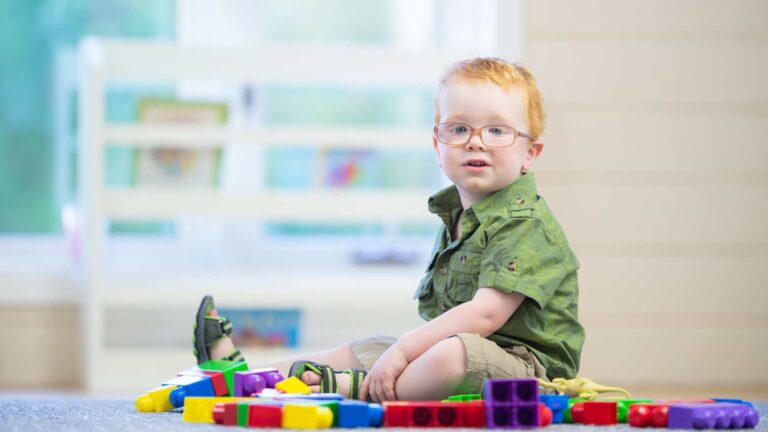Autism and challenging behaviors are correlated. Many individuals with autism, including children, adolescents, and adults, frequently exhibit challenging behaviors. These behaviors can add a layer of difficulty to their everyday lives and the lives of their parents and caregivers.
Research by the National Library of Medicine indicates that over half of the children and adolescents diagnosed with autism might display physical aggression toward their parents, caregivers, and peers. Moreover, problem behaviors among individuals with autism may also include hyperactivity, anxiety, worry, and even self-harming actions like biting or head banging. These behaviors exhibit varying severity, duration, and frequency levels across the autism spectrum.
Managing autism and challenging behaviors is complex, and the process can be overwhelming. Therefore, it’s crucial that if you are a parent or caregiver of a child with autism, you possess the necessary tools to address these complex behaviors. By offering support, patience, and informed strategies, you can assist your loved one in navigating these situations while also ensuring your well-being.
In this blog by Texas ABA Centers, we will provide ten tips for parents and caregivers coping with autism and challenging behaviors.
Understanding Autism and Challenging Behaviors
Individuals diagnosed with autism spectrum disorder (ASD) process stimuli differently from neurotypical individuals. This variation arises from differences in the development of their brains, causing people with autism to perceive and interpret the world uniquely. As a result, they often find challenges in their behavior, communication, and interactions with people and their environment.
Challenging behaviors hold significance for children with autism, underscoring the importance of comprehending them. These behaviors can serve as your child’s means of coping with anxiety, sensory overload, discomfort, or expressing their needs.
Every individual with autism presents unique symptoms and experiences of the condition. The spectrum encompasses varying levels of severity, with each individual exhibiting severe or mild symptoms. Consequently, each person with autism requires personalized support.
Autism and challenging behaviors are conditions, not diseases or decisions. People with autism can enhance their skills and behaviors to have bright lives. Applied Behavior Analysis (ABA) therapy is a scientific-based approach to achieve such improvements.
What Are The Challenging Behaviors Associated With Autism?
- Meltdowns: This reaction manifests when an individual loses complete control over their behavior due to an overwhelming situation. Meltdowns may manifest as screaming, crying, kicking, and even aggressive behaviors like biting. It’s important to note that kids with autism don’t have meltdowns with malicious intent; instead, they stem from challenges in expressing overwhelming emotions through alternative means.
- Stimming or Self-Stimulating Behaviors: Stimming refers to repetitive movements or sounds that individuals with autism use to regulate their emotions and manage anxiety and overstimulation. Some examples of stimming behaviors include repeating words and phrases, humming, sniffing, or licking repeatedly, making repetitive hand movements, rubbing the skin, flapping hands, blinking, rolling the eyes, gazing at lights, arranging objects in lines, spinning, rocking the body, and engaging in pacing or twirling.
- Deficient social skills: People with autism have difficulty establishing social interactions. Some behaviors that make interactions challenging are lack of eye contact, obsessive interests, and difficulty respecting personal space.
Autism and Challenging Behaviors Management Tips
- Embrace ABA therapy: ABA therapy is a science- and outcome-based approach to teaching behaviors and skills to children and adolescents with autism through positive reinforcement. ABA therapy seeks to strengthen and develop skills in communication, socialization, self-care, and behavior management, among others, thereby enabling children to thrive in their environment.
While ABA therapy can still be effective at later ages, early intervention can give better results. It’s important to note that challenging behaviors in kids with autism can evolve, and thanks to the brain’s plasticity during early developmental stages, professionals have observed better outcomes with ABA therapy and early intervention. - Identify what triggers your child’s challenging behaviors and anticipate them: Overwhelming feelings can cause most meltdowns in children with autism. A change in routine, a new location, anxiety, or difficulty communicating something can trigger meltdowns. Recognizing these situations will help you be aware of avoiding or addressing them in advance.
People with autism show signs before reaching a meltdown, known as the “ramble stage.” During this stage, they often show signs of anxiety, such as rocking, repetitive questions, pacing, or standing very still. Suppose you see your child exhibiting these behaviors. In that case, you can use distraction strategies to prevent reaching the ramble stage, such as offering a fun or calming activity, listening to music, or taking deep breaths. Remember to stay calm as well. - Use positive reinforcement: As mentioned earlier, positive reinforcement is a teaching strategy implemented in ABA therapy. Positive reinforcement seeks to recognize positive behaviors through a system of simple rewards. By implementing this teaching strategy, children increase their desire to learn and tend to repeat positive behaviors identified by their caregivers. Positive reinforcement plus ABA therapy allows your kid to replace undesired behaviors with new behaviors and skills.
- Set limits and rules: Setting them is a great way to help children with autism and challenging behaviors, as they benefit significantly from routines and structure. You can start with small time intervals, such as setting 2 minutes for quiet reading and then increasing the time. For each behavior the child completes successfully, you can give recognition, for example, five more minutes to play with their favorite toy.
Setting rules and limits and sticking to them is very important to teach your child that appropriate behavior results in a reward and challenging behavior has consequences, like losing a privilege. When a child with autism recognizes the expectations and results of their behaviors, they are more likely to engage in appropriate behaviors and increase their confidence levels.
- Be patient: We understand that dealing with autism and challenging behaviors is difficult and emotionally draining. However, learning to stay calm and be patient in times of crisis will help you react smarter, help your child feel safe and secure, and offer stability to regulate themselves. Staying calm is not only beneficial for your child but also for your health.
- Use visual aids to communicate with your child: Children with autism often learn best with visual aids, like pictures, flashcards, calendars, lists, and images. Using visual aids to teach your child behaviors, expectations, situations, and skills helps manage autism and challenging behaviors. With these resources, you can help your child understand expectations and what activities they will have throughout the day, providing a sense of control and predictability, reducing anxiety and challenging behaviors.
- Do not blame anyone: Autism and challenging behaviors are part of life. Please don’t blame yourself for your children’s behaviors. They are in a learning process like you. Have compassion and free yourself of blame.
- Avoid overload and reduce stress at home: Remember, you are not alone. As the World Health Organization (WHO) states, one out of every hundred children receives an autism diagnosis. If you need help, ask for it, and look for resources, communities, and organizations like Texas ABA Centers to find support. Being a parent and caring for a child with autism can be stressful for both parties, so finding ways to manage stress is significant.
Some ways to reduce stress include:
- Keeping a clean and organized space
- Using all available support tools
- Taking frequent breaks
- Having time alone
Children with autism require more care and support from their caregivers, so both of you must reduce your stress levels and thus have a good home environment.
- Create a safe environment: Creating a calm environment at home is very helpful in preventing challenging behaviors in children with autism, meaning that eliminating loud noises and bright lights from your home can go a long way in reducing your child’s stress levels. Also, you can create a calm corner, a safe place where your child can go to regulate their emotions. In this space, you can include a comfortable chair, a sensory cushion, toys with different textures, and play dough, among other objects, to help them calm down.
On the other hand, if you are in a public place and your child has a meltdown, try to create a quiet and safe space for them. Get away from people, turn off loud music and bright lights, and try anything to reduce stimulus overload. It’s also helpful to bring support items outside the home, such as noise-canceling headphones, dark glasses, or a squeeze ball.
- Add relaxation time into the routine: One way to deal with anxiety in children with autism and challenging behaviors is to add moments of relaxation into the daily routine. Activities include listening to music and singing their favorite songs, deep breathing, counting to 10, walking outside, etc.
Coping with Autism and Challenging Behaviors at Texas ABA Centers
At Texas ABA Centers, we understand that each child with autism has different symptoms and unique abilities. Through our ABA therapy services, we provide personalized plans based on the child’s symptoms and the needs of the child and their family. ABA therapy uses behavioral techniques to empower children, helping them acquire life skills that enable individual growth.
Our in-home ABA therapy services offer our patients and their families enhanced convenience. Receiving ABA therapy at home provides comfort and creates a safe, familiar environment for your child to learn, reducing stimuli and anxiety. Moreover, parents and caregivers can actively participate, observe sessions, ask questions, and learn techniques professionals recommend to manage autism and challenging behaviors.
Furthermore, our ABA therapy service employs a unique and practical approach called behavioral momentum. This approach enhances learning for children and adolescents on the autism spectrum. By emphasizing behavioral momentum, we increase the likelihood of successful skill acquisition and ongoing improvement. This approach makes ABA sessions more dynamic, engaging, and enjoyable.
To learn more about ABA therapy at Texas ABA Centers, contact us by filling out this online form or calling (877) 771-5725.









